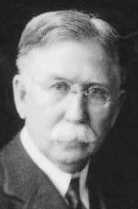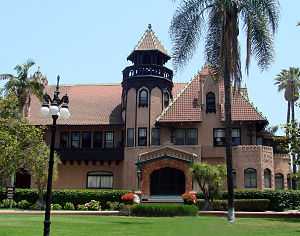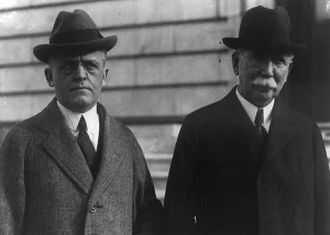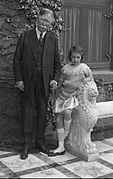Edward L. Doheny
| Edward L. Doheny | |
|---|---|
 | |
| Born |
Edward Laurence Doheny August 10, 1856 Fond du Lac, Wisconsin, United States |
| Died |
September 8, 1935 (aged 79) Los Angeles, California, United States |
| Occupation |
Miner Prospector Driller Businessman Philanthropist |
| Spouse(s) |
Carrie Louella Wilkins Carrie Estelle Betzold |
| Children |
Eileen Doheny Edward L. (Ned) Doheny, Jr. |
Edward Laurence Doheny (August 10, 1856 - September 8, 1935) was a U.S. oil tycoon, who in 1892, along with business partner Charles A. Canfield, drilled the first successful oil well in the Los Angeles City Oil Field, setting off the petroleum boom in Southern California.
At first he was an unsuccessful prospector in the state of New Mexico and South-Western United States. Later Doheny became very wealthy through his California oil interests, and was also successful in the oil fields of Tampico, Mexico. During the administration of President Warren G. Harding, Doheny was implicated in the Teapot Dome Scandal and was accused of offering a $100,000 bribe to Secretary of the Interior Albert Fall in order to secure drilling rights without competitive bidding to the Elk Hills Naval Petroleum Reserve in central California. He was twice acquitted of offering the bribe that Fall was convicted of accepting. Doheny and his second wife and widow, Carrie Estelle, were noted philanthropists in Los Angeles. The character J. Arnold Ross in Upton Sinclair's 1927 novel Oil! (the inspiration for the 2007 film There Will Be Blood) is loosely based on Doheny.
Early career
Doheny was born in Fond du Lac, Wisconsin to Patrick "Pat" and Eleanor Elizabeth "Ellen" (née Quigley) Doheny. His father was born in Ireland, and fled Tipperary in the wake of the Great Famine. Patrick tried whaling after leaving Ireland and arriving in Labrador.[1] His mother was born in St. Johns, Newfoundland, and was a former school teacher.[2] After Patrick and Ellen were married and moved to Wisconsin his father became a laborer, working construction, and a gardener.[3]
Doheny graduated from high school in his fifteenth year and was named the valedictorian of his class.[4] Following his father’s death several months after his graduation, he was employed by the U.S. Geological Survey, and in 1873 was sent to Kansas with a party surveying and subdividing the Kiowa-Comanche lands. The following year he left the Geological Survey to pursue his fortune prospecting, first in the Black Hills of South Dakota and then in Arizona Territory and New Mexico Territory.
He is listed in the 1880 United States Census as a "painter" living in Prescott, Arizona.[5] Later in 1880 he was in the Black Range in western Sierra County of south-western New Mexico Territory, living in the rough silver-mining town of Kingston (about 10 miles (16 km) west of Hillsboro), prospecting, mining, and buying and trading mining claims. He worked in the famed Iron King mine, just north of Kingston, that drew men to the area. During his time in Kingston he met two men who would play important roles in his later life; Albert Fall,[6] the future Secretary of the Interior, and his business partner Charles A. Canfield.[7]
Doheny and Canfield together worked the former’s Mount Chief Mine with little success,[7] and thus in 1886 Canfield prospected further in the Kingston area, leasing and developing with great success the Comstock Mine (not to be confused with the Comstock Lode of Virginia City, Nevada). Doheny declined to join him in this venture, and whereas Canfield made a small fortune from it, Doheny was reduced eventually to doing odd jobs (including painting) to support his family.[8]
In the Spring of 1891, Doheny left New Mexico and moved to Los Angeles, California, attracted by Canfield’s success in Los Angeles real estate. Canfield had previously left New Mexico with $110,000 in cash from his Comstock Mine venture, a sum that he parlayed into extensive real estate holdings during the Los Angeles boom of the later 1880s. With the collapse of the speculative fever, Canfield lost his wealth and land holdings and, by the time Doheny arrived in Los Angeles in 1891, was deeply in debt.[9]
Briefly the two men tried their prospecting luck in the San Diego County area of Southern California, forming the Pacific Gold and Silver Extracting Company there, but without achieving success they soon returned to Los Angeles.[9] By 1892, Doheny was so poor he could not afford to pay for his boarding room.[10]
Oil wells and success
While in Los Angeles, Doheny found out that there were reserves of natural asphalt which in places came to the surface, notably at the La Brea "tar pits". Doheny obtained a lease near downtown with $400 in financing from Canfield, who had made some money from the mining industry. In the fall of 1892 Doheny dug a well with picks and shovels, and a windlass, looking for asphalt, from which oil could be refined. When the well (6 feet (1.8 m) x 4 feet (1.2 m) wide) reached a depth of 155 feet (47 m) Doheny devised a drilling system involving a eucalyptus tree trunk.[10] The well, when completed in 1893, reached a total depth of 225 feet (69 m) and produced 40 barrels per day (6.4 m3/d). (The discovery of this well appears in John Jakes's novel California Gold, as do Doheny and Canfield as partners with the novel's fictional protagonist, Mack Chance.)
The first well dug in Los Angeles was in 1863, on Hoover Street between Seventh Street and Wilshire Boulevard, by a man named Baker. But in his book Petroleum in California: A Concise and Reliable History of the Oil Industry of the State, Lionel V. Redpath states that the oil industry in Los Angeles began with the Doheny and Canfield well at the corner of Patton and West State streets. Although the well was a small producer, it pumped steadily for three years, and during that time period about three hundred more wells were sunk.[11]

Doheny and Canfield soon made a fortune by drilling in the area and selling the oil to nearby factories. Later, they helped spur the California oil boom of the early 1900s (decade) by persuading railroads to switch from coal to oil as power for their locomotives.[10]
Doheny was also a pioneering oil producer in Mexico. His company drilled the Cerro Azul No. 4 well, which in February 1916 became the world's largest producing well, pumping 260,000 barrels per day (B.P.D.). When the well, drilled by Herbert Wylie, came in the sound could be heard 16 miles (26 km) away in Casiano and shot a stream of oil 598 feet (182 m) into the air, sending oil in a two-mile (three-kilometre) radius. Over the next fourteen years the well would produce over fifty-seven million barrels.[12] He formed the Pan American Petroleum and Transport Company (P.A.T.), part of which would later become the Mexican Petroleum Company (Pemex), to hold his two Mexican companies (Mexican Petroleum and Huasteca) and his Atlantic and Gulf Coasts facilities in the United States, as well as his California holdings.[12] The company owned 600,000 acres (2400 km²) of land worth about $50,000,000 and secured an additional 800,000 acres (3200 km²) in Mexico in October 1919.
In 1919 the Colombian Petroleum Company, a P.A.T. subsidiary, bought a 75% interest in the Barco oil concession in Colombia.[13] Doheny was also interested in plans to develop the oil industry in Venezuela, and in building a pipeline from Colombia to Venezuela to make it more economical to export the Barco oil.[14]
He sold a majority (retaining a minority stake) of the family's shares in Pan American Petroleum & Transport to Standard Oil of Indiana, on April first, 1925, but retained all the California assets, with which he formed his new company, Pan American Western Petroleum Company. Pan American Eastern Petroleum (the Mexico holdings, the Atlantic and Gulf Coasts holdings in the U.S., refineries, pipelines, and thirty-one tankers), which held the non-California assets, was sold to Standard. Pan American Western returning to its roots as an "upstream" exploration and production company.[15]
Politics

Doheny's reputation was somewhat tainted by a bribe paid to the Secretary of the Interior, Albert B. Fall. The "gift" of $100,000 was made in connection with obtaining a lease of 32,000 acres (130 km²) of government-owned land used for the Elk Hills Naval Petroleum Reserve near Taft, California. The resulting scandal broke soon after that over similar bribes Fall accepted for leasing Teapot Dome in Wyoming. Doheny was charged with bribing Fall, but was acquitted. The scandal is also the inspiration for Upton Sinclair's novel, Oil!, based in part on Doheny's life.[10] Paul Thomas Anderson's film There Will Be Blood (2007) was in turn loosely based on Sinclair's book.
Philanthropy
Doheny contributed money to foundations. He helped fund the construction of St. Vincent de Paul Church. After the tragic shooting death of his son, he donated $1.1 million in 1932 to University of Southern California (U.S.C.) to build the Edward L. Doheny, Jr. Memorial Library.[16] His second wife, Carrie Estelle Doheny donated her rare book collection to St. John's Seminary in Camarillo, California.
Doheny, Sr., meanwhile, lived in his own mansion, which he had purchased in 1901.[17] Part of Chester Place, a gated community of Victorian mansions, Doheny ended up owning most of the houses, as well as the street, by the time of his death in 1935.[18] Built in 1899 in the French Gothic architectural style, this three-story, twenty-two-room residence was damaged in the 1933 earthquake but was repaired, and is now part of Mount St. Mary's College's campus, where it houses college departments, runs docent tours, and hosts chamber music concerts by The Da Camera Society.
The Dohenys also owned a great deal of coastal land in Dana Point, California, which was donated to the State of California for Doheny State Beach as a memorial to Edward's murdered son Ned. They also donated the funds for the construction of the original site of St. Edward the Confessor Roman Catholic Church, which has since moved to a bluff-top location overlooking Doheny State Beach. The original building is now home to San Felipe de Jesus Roman Catholic Church.
After he began basing his Mexican oil operations near Tampico, Tamaulipas in 1902, Doheny donated much money towards the construction and maintenance of the Cathedral of Tampico, also known as The Temple of the Immaculate Conception, located in Plaza de Armas.
The Doheny Estate has donated money for the construction of buildings and residence halls to Loyola Marymount University and the land for one of the campuses of Mount St. Mary's College south of downtown Los Angeles.
In 1944, Carrie Estelle Doheny suffered a hemorrhage, leaving her partially blind. Realizing the value of good vision, she created and funded the Doheny Eye Institute,[19] which today has become a world leader in vision research.
Doheny took his yacht, the Casiana (named after his first major producing oil well in Mexico, the Casiana No. 7), to Martinique to pick up a friend's brother who worked as a farmer on the island and who was seriously ill. Doheny brought him back to New York; the steam yacht was able to make the trip in only five days.
Family

In 1883, in the Black Mountains town of Kingston in the New Mexico Territory, Doheny met and married his first wife, Carrie Louella Wilkins, on August seventh.[20]
Their daughter, Eileen, was born in December, 1885.[20] Eileen was a frail child and died at the age of seven years on December fourteenth, 1892. Her death was caused by heart disease stemming from rheumatic fever as well as a lung infection.[21]
Edward and Carrie's marriage was a fragile one, owing mostly to the harsh reality of mining life as well as their many financial problems.[22] Eileen's death further strained their marriage. Nearly a year after Eileen's passing, on November sixth, 1893, Carrie gave birth to their only son Edward Jr., known as Ned.[23]
Edward and Carrie divorced in 1899, when Ned was six years old.[24] After losing custody of Ned and Edward's marriage to another woman, Carrie committed suicide the following year.[25]
Edward married his second wife, Carrie "Estelle" Betzold, inside the private Pullman car of Santa Fe Railway executive Almon Porter Maginnis ("Car 214"),[26] on the siding in New Mexico Territory, on August twenty-second, 1900.[27] Although she bore no children, Carrie raised Ned.[28]
Doheny is also famous for another of his gifts — the gift of Greystone Mansion (designed by Gordon B. Kaufmann after a design competition) to his son, Edward (Ned) L. Doheny, Jr., and wife Lucy Marceline Smith (the couple was married on June tenth, 1914).[29] He built the 46,000-square-foot (4,300 m2) house in 1928 at a cost of $3,188,000, selling the property and the accompanying 400-acre (1.6 km2) ranch to his son for $10.[18] In 1929, during the midst of the Teapot Dome scandal, Doheny's son, Ned died at Greystone mansion, in a still incomplete story, a murder-suicide involving himself and his friend and secretary Theodore Hugh Plunkett.[30][31] In his novel The High Window, former oil man Raymond Chandler (who came to work for the Dabney Oil Syndicate in 1922 as a book-keeper and auditor, but was fired a decade later) included a thinly veiled account of the Doheny murder as an example of a hushed-up case.[32]
Beset by shareholder lawsuits in the wake of Teapot Dome, and the death of Ned, Doheny became a recluse and invalid.[33] When she realized her husband needed an undisturbed home away for a while after the Teapot Dome travails and Ned's death, Carrie Estelle asked architect Wallace Neff to design and build the Ferndale Ranch complex on their Ojai, California property.[34] Hundreds of workers completed the 9,000 square feet (840 m2) house in less than six weeks, including Neff's blueprints, by working day and night.[18][35]
Edward L. Doheny died on September 8th, 1935, of natural causes, a month after his seventy-ninth birthday. His funeral was in St. Vincent's Church in Los Angeles.[36]
The legacy of the family name remains in Southern California: with Doheny Drive in West Hollywood and Beverly Hills; with Doheny Road also in Beverly Hills; with Doheny State Beach, on the Pacific coast of Orange County, in Dana Point; and with the principal library at the University of Southern California, which was named in memorial of his son, Ned.
Carrie Estelle Doheny, during and after her husband's death, was a major cultural philanthropist in Los Angeles, California. When commissioning new buildings for these civic projects she often chose the renowned Southern California architect Wallace Neff. Upon her death she left antiquities and funds to St. John's (Roman Catholic) Seminary located in Camarillo, in Ventura County, Southern California
In 1954. Mrs. Estelle Doheny provided funds as well as "a quantity of her precious collections in the library building" at St. Mary's of the Barrens seminary in Perryville, Missouri.[37] By November 11, 2000, the Vincentian Fathers signed a contract with Southeast Missouri State University for use of the library building. So, "the Doheny treasures were sold."[38]
Edward and Estelle Doheny were the great-grandparents of Larry Niven (the science fiction writer),[39] and numerous Doheny descendants [40]
See also
 Los Angeles portal
Los Angeles portal Biography portal
Biography portal
References
Notes
- ↑ Davis. - p.8.
- ↑ Davis. - p.196.
- ↑ Davis. - p.9.
- ↑ Davis, Margaret L. (1998). Dark Side of Fortune: Triumph and Scandal in the Life of Oil Tycoon Edward L. Doheny. Berkeley: University of California Press, 1998. ISBN 0-520-22909-6.
- ↑ Prescott, Yavapai, Arizona. 1880 United States Census. United States Census Bureau. page.462B.
- ↑ Davis. - p.14.
- ↑ 7.0 7.1 Davis. - p.11.
- ↑ Davis. - pp.18-19.
- ↑ 9.0 9.1 Davis. - p.20.
- ↑ 10.0 10.1 10.2 10.3 Yewell, John (December 13, 2007). "Black gold gave state its glitter". The Monterey County Herald.
- ↑ Redpath, Lionel V. (1900). Petroleum in California: A Concise and Reliable History of the Oil Industry of the State. pp. 37–38.
- ↑ 12.0 12.1 Davis. - pp.107-109.
- ↑ Vassiliou, M. S. (2009-09-24). The A to Z of the Petroleum Industry. Scarecrow Press. p. 139. ISBN 978-0-8108-7066-6. Retrieved 2013-07-24.
- ↑ McBeth, B. S. (2002-04-04). Juan Vicente Gómez and the Oil Companies in Venezuela, 1908-1935. Cambridge University Press. p. 95. ISBN 978-0-521-89218-6. Retrieved 2013-07-24.
- ↑ Davis. - p.186.
- ↑ Edward Doheny. University of Southern California (USC).
- ↑ Bonino, Mary Ann (also publisher) (2008). The Doheny Mansion: A Biography of a Home. pp. 37–38. ISBN 978-0-9816422-0-8.
- ↑ 18.0 18.1 18.2 Sloper, Don (2006). Los Angeles's Chester Place, Arcadia Publishing, 2006. ISBN 0-7385-4687-9
- ↑ History. Doheny.org.
- ↑ 20.0 20.1 Davis. - p.13.
- ↑ Davis. - p.24.
- ↑ Davis. pp.16-21.
- ↑ Davis. - p.29.
- ↑ Davis. - p.33.
- ↑ Davis. - p.41.
- ↑ Bonino. - p.28.
- ↑ Davis. - p.40.
- ↑ Doheny Foundation.
- ↑ Davis. - pp.212-213.
- ↑ Today in LA history: the Doheny murder.
- ↑ Davis. - p.232.
- ↑ McCartney, Laton (2008). The Teapot Dome Scandal: How Big Oil Bought the Harding White House and Tried to Steal the Country. New York: Random House.
- ↑ West Adams Heritage Society, biographical sketch of Edward L. Doheny.
- ↑ Davis. - pp.247-248,270-272.
- ↑ Davis. - p.247.
- ↑ Davis. - p.274.
- ↑ Southeast Missouri State University. "St. Mary's of the Barrens--Perryville,Missouri". Website. Southeast Missouri State University. Retrieved 5 December 2013.
- ↑ Southeast Missouri State University. "St. Mary's of the Barrens--Perryville, Missouri". Website. Southeast Missouri State University. Retrieved 5 December 2013.
- ↑ "The Niven File" in 'Writers for Relief: An Anthology to Benefit the Survivors of Katrina' .
- ↑ [http://articles.latimes.com/1991-12-26/news/vw-1296_1_holiday-fling. Lucy Estelle Doheny - A Holiday Party That Sparkles Aplenty].
Bibliography
- Ansell, Martin R. (1998), Oil Baron of the Southwest: Edward L. Doheny and the Development of the Petroleum Industry in California and Mexico, Columbus, Ohio: Ohio State University Press, ISBN 978-0-8142-0749-9
- Davis, Margaret Leslie (1998), Dark Side of Fortune: Triumph and Scandal in the Life of Oil Tycoon Edward L. Doheny, Berkeley: University of California Press, ISBN 978-0-520-22909-9
- La Botz, Dan (1991), Edward L. Doheny: Petroleum, Power and Politics in the United States and Mexico, New York: Praeger, ISBN 978-0-275-93599-3
External links
| Wikimedia Commons has media related to Edward L. Doheny. |
- Doheny Mansion
- Edward L. Doheny, Jr.. Memorial Library at USC
- "Text of Edward L. Doheny Jr. Memorial Library"
- Family retreat in Franklin Canyon
- "Edward L. Doheny". Find a Grave. Retrieved September 3, 2010.
| ||||||||||||||||||||||
|